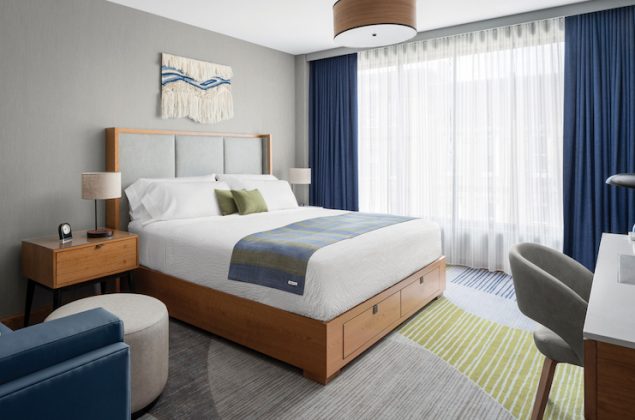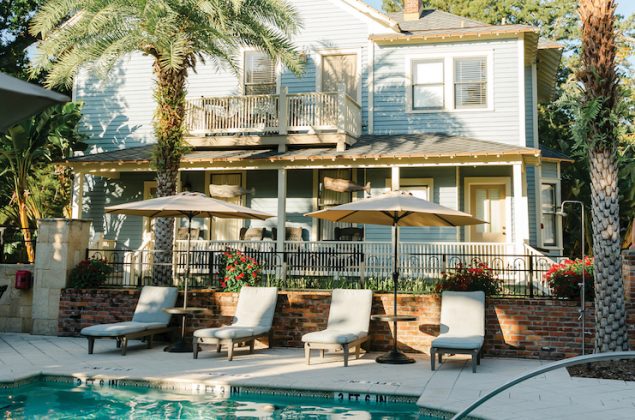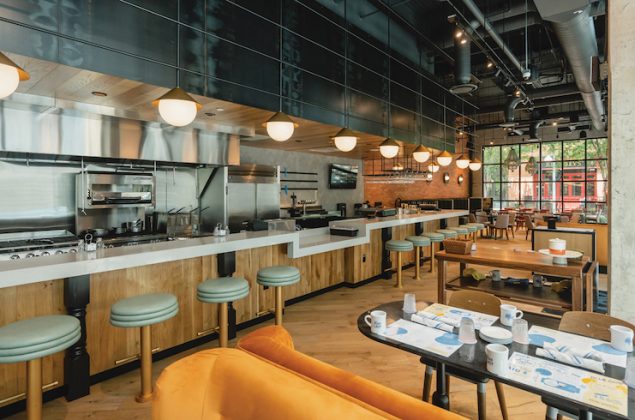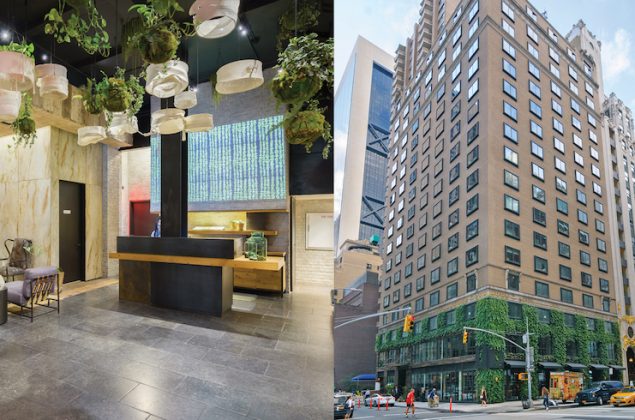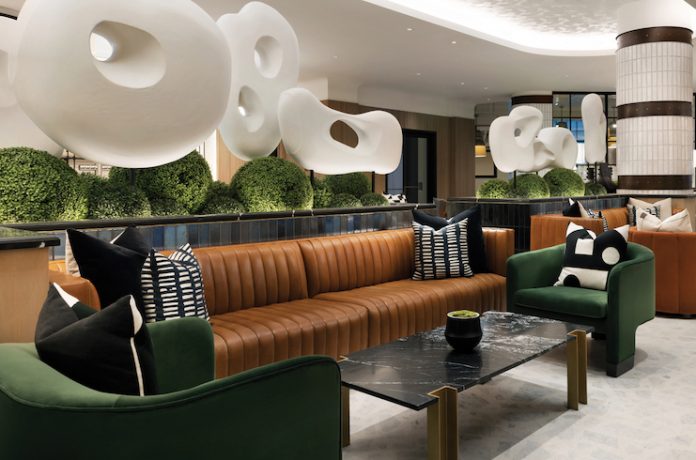
Hotel construction and design have always involved balancing numerous considerations, including brand identity, the latest guest expectations, local flair and authenticity, and sustainability. But more recently, costs and timelines have become especially prominent factors, given escalating prices for building services, supply chain disruptions, and staffing shortages. According to recent data from STR, these obstacles have slowed U.S. hotel development, with the first half of 2022 showing new openings 50 percent behind the same period last year (see page 34 for details).
Nonetheless, many developers are seeing a robust pipeline of projects. “There has been a flurry of activity over the past several months as we emerge from the pandemic,” notes Paul McElroy, executive vice president at Lucid, Highgate’s Design and Construction division. “A considerable number of projects were paused in early 2020, with many of these projects coming back to life as investor confidence continues to grow. We are seeing strong activity across our branded Full Service, branded Select Service, and independent Luxury Lifestyle divisions. We currently have active projects in all major gateway markets, including New York City, Miami, San Francisco, Southern California, Arizona, Honolulu, and Maui.”
In the boutique segment, Charlestowne Hotels is seeing high demand for development, especially in secondary and tertiary markets. “The next three years look very strong for Charlestowne Hotels. We’re seeing an 80-20 split between new builds and conversions,” says CEO Kyle Hughey. “Overall, it may have slowed down a bit but it’s a mixed bag for us as we have a diverse group of clients that are in different phases of the process. A new build or conversion has a longer project timeline, so we have clients that started over 12 months ago and are moving forward as planned. An example is that in the current 90-day window, we opened Origin Hotel Austin in Austin, Texas, and are opening Lockwood Hotel in Waterville, Maine.”
In the New York City first-tier market, CNY Group is also seeing strong development activity. “Our pipeline is excellent,” says AnaTracey Hawkins, vice president of strategic growth at CNY Group. “We have seven opportunities that will be in various stages starting in 2023. And we believe that’s an indicator of continued growth.” She adds, “At the moment, activity definitely seems to be leaning more toward conversions, although we are in pre-construction for some new builds as well. There is a lot of obsolete inventory in the hotel space and other spaces in New York City that can be adaptively reused.”
So while new openings have slowed overall, many developers and construction firms still have a full plate of projects and need to exercise resourcefulness in order to deliver them cost effectively. “Everyone knows the cost of construction has been going through the roof, increasing almost all the time, and it just gets harder and harder to make a new development deal happen,” observes Steve Schrope, director, CBRE Hospitality Project Management. Schrope feels that while the higher costs are affecting both new builds and conversions, new builds are impacted a bit more. “Some of the drivers for significant cost increases in steel and drywall just don’t happen to us as much in renovations and conversions,” he says. “And, frankly, some renovations and conversions have to happen, no matter what is going on in the construction market.”
Meanwhile, supply chain delays and increased shipping costs are affecting both construction and FF&E, and therefore it is advisable that hoteliers “plan ahead and execute contracts as early as possible,” Schrope adds. In the early stages of the project, all team members who can inform budgeting and planning should be engaged in order to “understand all the risk factors,” McElroy recommends. Those team members include purchasing agents and freight-forwarding companies, who are “more important than ever as we strategize against the unprecedented increases in shipping costs and global supply chain challenges.” With input from all these key parties, the project can be set up for success. “Building a budget at the onset of a project that adheres to the desired design objective, with a specific schedule is critical,” McElroy says. “Projects also need to be assessed on a standalone basis and market to market to ensure the most appropriate procurement method is being adopted.” And with the volatility of the construction market, initial budgets may need to be more regularly reassessed. “In many instances, budgets that are less than 12 months are already obsolete and need to be revisited before material dollars are invested into projects,” says McElroy. “Having a multidimensional and talented team of professionals that can not only estimate in real time, but also make informed design decisions in real time, is so important in managing costs and mitigating budget overruns.”
Compounding the challenge of rising construction and shipping costs is the escalation in interest rates, which in some cases accounts for the pullback in new projects. “People are going to wait to see if there is fluctuation in construction costs and interest rates—both can’t be high. That’s what’s causing the pause,” says Hughey. “There is not a lot we can do about higher building costs. The demand for those services is staying high, so therefore, they’re not going to drop their prices. What we do look at is return and best value.”
Value Engineering
Reducing the cost of the project while delivering the quality and experience that developers and guests expect is a major objective given the current market conditions. “A good construction company really works together early with the design team, because it’s while the designers are designing that we have the most impact on cost,” Hawkins explains. “So we research alternative materials, for example, and work really hard to keep the design integrity intact. That’s one of the reasons why I believe we’re consistently chosen to work on hotel projects because that’s one of our primary concerns: How can we keep the design integrity intact and lower the costs?”
As Hawkins suggests, the use of alternative, less expensive materials is one of the major strategies in play. And fortunately, the current materials market is not short on options for builders. Schrope observes, “Whether it’s tile, carpet, LVT [luxury vinyl tiles], etc., there is an entire galaxy of products out there at different price points. And so part of the value engineering exercise is really drilling down on those components and seeing where we might be able to do something a little less expensively, but still deliver a level of quality that meets brand requirements and meets owners’ and guests’ expectations. For example, you might go from a true tile floor or wood floor to LVT, which looks similar and has some of the same characteristics, but is delivered at a slightly lower price.” Another approach that is gaining traction is the use of prefabricated components, which typically reduces labor costs. Prefab components can include everything from bathrooms to hotel facades. “There is a movement to use prefab bathroom modules and set them into hotel rooms, but I wouldn’t say they’re overly popular yet,” says Schrope. “We see a lot of prefab work now in the exterior skin. So an exterior wall panel can be completely prefab, sometimes even with the internal guts of it (e.g., electrical wiring), and it is then lifted into place. And there is always an interest in finding new, better, and less expensive structural systems. We’ve seen a lot of engineered light gauge metal systems that are basically like edge metal framing; its pre-engineered and sort of built from a kit of parts. So those are opportunities to reduce overall construction costs.”
Shrinking the footprint of the facilities can be another cost saver, assuming that approach aligns with the hotelier’s vision. Smaller guestrooms are one possibility. “Brands are increasingly interested in, or increasingly willing to, consider a smaller footprint for a guestroom,” says Schrope. “The overall guestroom size is reduced, and some of the amenities that used to be in the guestroom are put into the lobby, into a more shared setting. For example, the prototypical room for the Marriott Moxy is significantly smaller than the traditional guestroom. Of course, there are fewer amenities in there. But it’s an interesting option, particularly in expensive urban markets.” Saving space and building costs can also be accomplished by omitting a business center from the design plan. While it’s important to cater to business and “bleisure” travelers, these facilities have become somewhat outmoded as many guests prefer to work on their laptops at other locations on property. “Historically, the business center was kind of going away, and that trend is continuing,” says Schrope. “So now we are starting to see a broader range of seating options within lobbies to allow for people to do some work there. It saves a lot of space. In some ways, the lobby starts to look a lot like an airport lounge, with many of the same services.”
Creative Conversions
Avoiding a generic hotel experience is a principle that is influencing the design of new properties. While signature elements that define brand identity are important, a unique design—perhaps one that reflects the individuality of the location—is more suited to the tastes of the modern traveler, particularly Millennials. “Designers are working with a newfound appreciation and respect for the idea of authenticity,” says Schrope. “Even though a hotel may be a prototypical box of a brand, designers figure out ways to acknowledge the specific location and the specific circumstances that it’s in, e.g., an F&B facility that is geared toward what’s happening locally. And some of the successful lifestyle brands that live within the larger brands, whether it’s Curio Collection by Hilton or Marriott Autograph Collection, really push the idea that this feels more like an independent boutique property.”
The desire to capture uniqueness and authenticity will often inform the conversion of historic buildings, where the structure’s past can be given a new life. One example comes from a conversion in the nation’s oldest city. “Charlestowne’s portfolio includes a number of unique projects, but my favorite example is The Collector Luxury Inn & Gardens in St. Augustine, Florida, which is comprised of nine historic homes, dating from 1790-1910 on a single city block,” Hughey relates. “The conversion to a hotel and the garden component allows us to tell its story through art, architecture, and physical immersion. It’s a truly unique property.” At the same time, Charlestowne balances a property’s individual character with its brand identity, he adds. “When renovating our independently branded hotels within the luxury lifestyle division, we also look for a signature design element or statement that speaks to the independent brand we are creating. It’s a very important part of our design process.” Examples of biophilic design are increasingly cropping up among new builds and conversions. “We always look to incorporate biophilic design into our projects when possible,” says McElroy. “We firmly believe in giving our guests and employees every opportunity to connect to nature as they traverse our properties.” For inner-city properties, it is perhaps especially desirable to create some connection to nature. An example comes from CNY Group, which focuses on the New York market. “1 Hotel Central Park was actually a commercial building, which we converted into a luxury hotel,” says Hawkins. “That encompassed biophilic design. It was an early adopter of bringing more of nature into the space, which is something we saw as well in the EDITION Hotel in Times Square, with its terrace restaurant. The indoor/outdoor concept is one of the trends that we are seeing continuing to grow stronger.”
Even properties that are already well connected to nature are enhancing their biophilic quality through renovations. For example, Lucid has done significant work at the ‘Alohilani Resort Waikiki Beach, converting an old, unused rooftop into a multilevel, 18,000-square-foot infinity pool deck, bar, and entertainment venue. As part of the project, the resort’s Oceanarium was given a stronger presence. “We retrofitted an existing lobby with nine-foot ceilings into a dramatic 20-foot-high space by demolishing an entire floor in the building and opening up views to the 260,000-gallon Oceanarium,” McElroy relates. As these projects illustrate, hotel development is an exercise in creativity and vision. But with the added challenges of higher costs and supply chain disruptions, value engineering and time management have come to the fore as all-important aspects. Despite the recent slowdown, it is encouraging to see hoteliers, designers, and builders stepping up to the plate and bringing dynamic new properties to market.
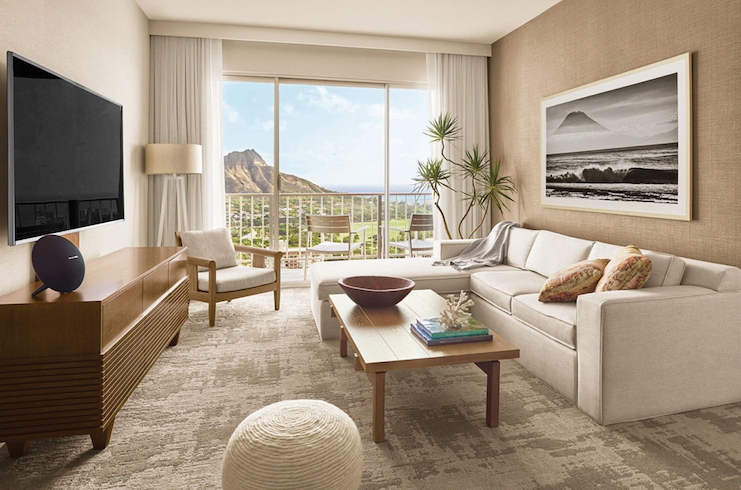
Sustainability Standouts Conversions That Take Environmental Responsibility to New Levels
Along with the movement to improve the sustainability of existing properties, new build and conversion projects typically have sustainability goals—as does the construction process itself. Paul McElroy, executive vice president at Lucid, Highgate’s Design and Construction division, highlights changes that have helped to “green” the company’s operations. “In conjunction with our VP of sustainability, we have established several best practices focusing on diverting furniture liquidation to a new use, minimizing construction waste, and most notably, partnering with MindClick to audit the business practices of our FF&E vendors from a sustainability viewpoint,” he explains. “On our recent Park Central San Francisco conversion to the Hyatt Regency San Francisco, we partnered with MindClick and achieved their highest rating available, Leader Status, for sustainability practices.” Another of Lucid’s environmentally sound projects is the renovation of the ‘Alohilani Resort Waikiki Beach, which was recently named the first certified Carbon Neutral Hotel in Hawaii. “Through its partnership with the Hawaiian Legacy Reforestation Initiative (HLRI) and Legacy Carbon, LLC, the property will offset the carbon footprint of every guest stay through the planting and electronic tracking of more than 550,000 native and endemic Hawaiian trees,” McElroy notes.
A trailblazing example of a green property is the Hotel Marcel, which opened in May. Located in New Haven, Connecticut, the hotel is housed in a converted brutalist building designed by modernist architect Marcel Breuer in the 1960s. Operated by Charlestowne Hotels, the property is “aspiring to be the country’s first sustainable net-zero energy hotel, meaning it will generate 100 percent of its own electricity and energy required to operate the hotel,” explains Kyle Hughey, CEO of Charlestowne Hotels. The property features more than 1,000 solar panels meeting all energy needs for lighting, heating, and cooling. In addition, architecture studio Becker + Becker used recycled and locally sourced building materials, high-performing thermal insulation, and low-voltage POE/LED lighting. EV charging stations were installed as well. “One green feature that’s becoming critical to offer at any property is an EV charger,” Hughey adds. “Every property we’ve developed in the past three years has at least one or two available for guests.”

